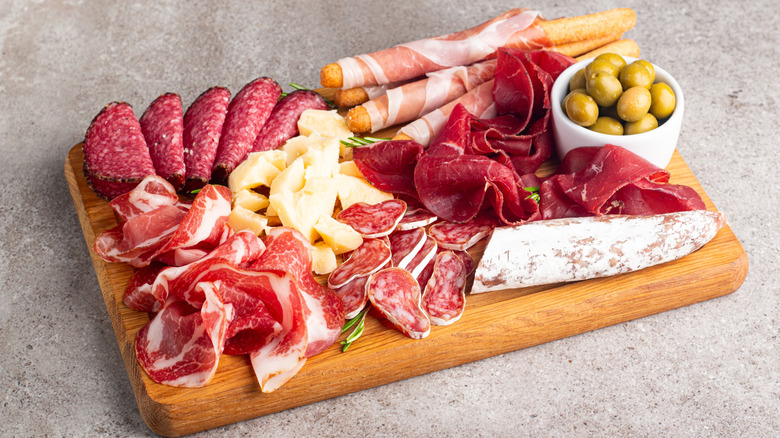The Charcuterie Board Mistake Everyone Makes Their First Time
Say what you will about the French, but they sure know how to make their guests feel special. Particularly when it comes to putting together the perfect combination of meats, cheeses, fruits, crackers, and a number of other accompaniments on an elegantly arranged, mouthwatering charcuterie board. "Charcuterie" is a French word that literally translates to "cooked flesh" in English, and in its place of origin (medieval France, though many would argue it goes way back to ancient times), it initially represented the process of curing and preserving pork.
Today, charcuterie boards have become the ultimate party staple. They're an easy yet sophisticated way for individuals to boast their presentation skills when guests arrive — that is, if they've followed the golden rule for filling in any charcuterie board. When attempting to build one, you should always start by placing the largest pieces first and then fill the gaps with the rest of your ingredients. But to truly nail the art of crafting the perfect board, there's one particular rookie mistake you should take care to avoid: overcrowding.
When explaining the 14 mistakes you're making when building a charcuterie board, George Guzman, executive chef of the Mediterranean-inspired wine bar Carta, told Chowhound how important it is to consider size and texture when building one. "A common mistake is using a board that's too small or overcrowded," he said in our exclusive interview. While you might be tempted to include all six types of cheese you bought at the store, keeping things simple will make the board far more appealing.
Why sometimes less is more
When designing a charcuterie board, a great way to start is by choosing a board that's big enough to fit all of your ingredients so everything looks well-organized and inviting. A 20×10-inch board is great for bigger groups, while a 12×8-inch model is ideal for smaller ones. While including a wide variety of meats and cheeses is one of our four expert-approved tips for building better charcuterie boards, try not to go overboard and make sure to evenly spread them on it. About 2 to 3 ounces of meat and cheese per person is more than a decent start. Give your guests too many options on the platter, and they'll easily end up more overwhelmed than impressed.
What's more, a messy board will make it harder for them to grab what they want and mix up the flavors, ultimately killing the evening's vibe. By giving each item a little room, you'll let the board breathe and allow the true flavors of every ingredient to stand out. "A well-assembled charcuterie board should have enough space for each item to stand out rather than feeling piled on top of each other," Guzman told Chowhound in our exclusive talk.
Finally, grouping similar items together and adding bowls and platters of different shapes and sizes is a must. This will not only make it easier for people to find their way around the board and pick what they like but also add a whole new depth to it. Once you nail the setup, just sit back and enjoy!

